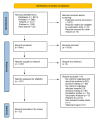The Complex Dynamics of Decision-Making at the End of Life in the Intensive Care Unit: A Systematic Review of Stakeholders' Views and Influential Factors
- PMID: 38406151
- PMCID: PMC10893775
- DOI: 10.7759/cureus.52912
The Complex Dynamics of Decision-Making at the End of Life in the Intensive Care Unit: A Systematic Review of Stakeholders' Views and Influential Factors
Abstract
A lack of consensus resulting in severe conflicts is often observed between the stakeholders regarding their respective roles in end-of-life (EOL) decision-making in the ICU. Since the burden of these decisions lies upon the individuals, their opinions must be known by medical, judicial, legislative, and governmental authorities. Part of the solution to the issues that arise would be to examine and understand the views of the people in different societies. Hence, in this systematic review, we assessed the attitudes of the physicians, nurses, families, and the general public toward who should be involved in decision-making and influencing factors. Toward this, we searched three electronic databases, i.e., PubMed, CINAHL (Cumulative Index to Nursing & Allied Health), and Embase. A matrix was developed, discussed, accepted, and used for data extraction by two independent investigators. Study quality was evaluated using the Newcastle-Ottawa Scale. Data were extracted by one researcher and double-checked by a second one, and any discrepancies were discussed with a third researcher. The data were analyzed descriptively and synthesized according to the Preferred Reporting Items for Systematic Reviews and Meta-Analyses (PRISMA) guidelines. Thirty-three studies met our inclusion criteria. Most involved healthcare professionals and reported geographic variations in different timeframes. While paternalistic features have been observed, physicians overall showed an inclination toward collaborative decision-making. Correspondingly, the nursing staff, families, and the public are aligned toward patient and relatives' participation, with nurses expressing their own involvement as well. Six categories of influencing factors were identified, with high-impact factors, including demographics, fear of litigation, and regulation-related ones. Findings delineate three key points. Firstly, overall stakeholders' perspectives toward EOL decision-making in the ICU seem to be leaning toward a more collaborative decision-making direction. Secondly, to reduce conflicts and reach a consensus, multifaceted efforts are needed by both healthcare professionals and governmental/regulatory authorities. Finally, due to the multifactorial complexity of the subject, directly related to demographic and regulatory factors, these efforts should be more extensively sought at a regional level.
Keywords: do-not-resuscitate order; end-of-life decision-making; paternalism; shared decision-making; withdrawing life-sustaining treatment; withholding life-sustaining treatment.
Copyright © 2024, Georgakis et al.
Conflict of interest statement
The authors have declared that no competing interests exist.
Figures
Similar articles
-
The future of Cochrane Neonatal.Early Hum Dev. 2020 Nov;150:105191. doi: 10.1016/j.earlhumdev.2020.105191. Epub 2020 Sep 12. Early Hum Dev. 2020. PMID: 33036834
-
A qualitative systematic review of internal and external influences on shared decision-making in all health care settings.JBI Libr Syst Rev. 2012;10(58):4633-4646. doi: 10.11124/jbisrir-2012-432. JBI Libr Syst Rev. 2012. PMID: 27820528
-
Beyond the black stump: rapid reviews of health research issues affecting regional, rural and remote Australia.Med J Aust. 2020 Dec;213 Suppl 11:S3-S32.e1. doi: 10.5694/mja2.50881. Med J Aust. 2020. PMID: 33314144
-
Physicians' attitudes and experiences about withholding/withdrawing life-sustaining treatments in pediatrics: a systematic review of quantitative evidence.BMC Palliat Care. 2023 Sep 29;22(1):145. doi: 10.1186/s12904-023-01260-y. BMC Palliat Care. 2023. PMID: 37773128 Free PMC article.
-
Physician decision-making process about withholding/withdrawing life-sustaining treatments in paediatric patients: a systematic review of qualitative evidence.BMC Palliat Care. 2022 Jun 24;21(1):113. doi: 10.1186/s12904-022-01003-5. BMC Palliat Care. 2022. PMID: 35751075 Free PMC article.
Cited by
-
Family-centered care: addressing challenges and implementing countermeasures in response to novel coronavirus pneumonia prevention and control-a narrative review.J Thorac Dis. 2024 Nov 30;16(11):8014-8025. doi: 10.21037/jtd-24-960. Epub 2024 Nov 21. J Thorac Dis. 2024. PMID: 39678865 Free PMC article. Review.
References
-
- Variations in end-of-life practices in intensive care units worldwide (Ethicus-2): a prospective observational study. Avidan A, Sprung CL, Schefold JC, et al. Lancet Respir Med. 2021;9:1101–1110. - PubMed
-
- Withdrawal of mechanical ventilation in anticipation of death in the intensive care unit. Cook D, Rocker G, Marshall J, et al. N Engl J Med. 2003;349:1123–1132. - PubMed
-
- Engelhardt HT. Oxford, UK: Oxford University Press; 1995. The Foundations of Bioethics. Second Edition.
-
- Worldwide similarities and differences in the foregoing of life-sustaining treatments. Sprung CL, Eidelman LA. Intensive Care Med. 1996;22:1003–1005. - PubMed
-
- Discrepancies between perceptions by physicians and nursing staff of intensive care unit end-of-life decisions. Ferrand E, Lemaire F, Regnier B, et al. Am J Respir Crit Care Med. 2003;167:1310–1315. - PubMed
Publication types
LinkOut - more resources
Full Text Sources
Miscellaneous

